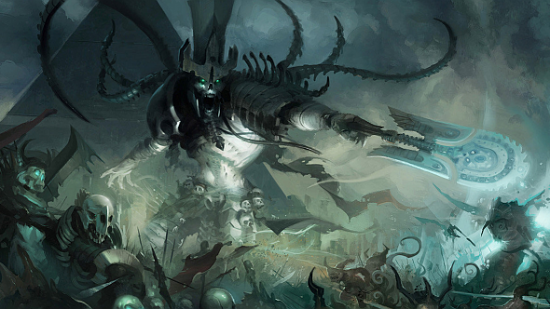About a month ago, we got to play with Total War: Warhammer II’s forthcoming Tomb Kings. The fruits of our hands-on time have now ripened and are available for your consumption on the site: to learn what tricks they will bring to the party, check out our Tomb Kings army guide; and to get a sense of how Settra’s campaign begins, check out our gameplay preview.
We also had the chance to speak with Richard Aldridge and Gary Deans, the lead and associate designers on Creative Assembly’s Warhammer DLC team. We discussed the design of the Tomb Kings, how it reflects their lore, their campaign (and the possibility of seeing a certain Great Necromancer), and plenty more odds and ends.
Total War: Warhammer 2 was one of the best games of 2017.
PCGamesN: I’m always interested to see how you guys change the campaign mechanics with every new race in Total War: Warhammer. With the Tomb Kings, there’s no recruitment cost, no unit maintenance, and not even a cap on basic skeleton units, which means you can field 20-stack armies right from the get-go, right?
Richard Aldridge: Yeah, you can. We want to incentivise that idea of bringing back these legions of fallen warriors very quickly, and you can re-supplement yourself time and again, so you don’t need to worry about losing them in battle. It also didn’t feel right that Tomb Kings would be spending their precious gold – which they want to craft into magical items – on these fallen soldiers.
PCGN: Sure. And they retain all the advantages of being undead, so no morale, for instance. When you can build up a huge force like that so quickly, what would you say are their weaknesses as an army?
Gary Deans: They definitely suffer in terms of their basic units, their fodder units – they’re not the greatest combatants, not at all. They also suffer in that they lack armour piercing. For instance, I came up against the Dwarfs in a campaign I played recently, who have high melee defence, high armour, and they’re just a wall of shields. And for Tomb King players, your armour-piercing units are few and far between in the early game, so getting into [Dwarf] strongholds is a challenge for sure.
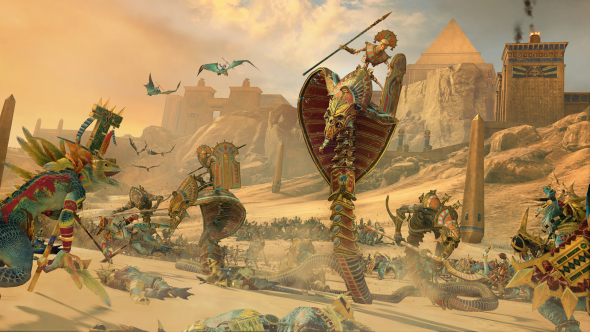
PCGN: Another limitation when it comes to more powerful units is the global cap on their recruitment, unlike the fodder units. How will we raise that cap?
Aldridge: You’re going to go out into the campaign as one of these four fallen Pharaohs. They’ve just awakened back into this world and they’re not happy – this isn’t the paradise they were expecting – and they are absolutely hellbent on restoring the prosperity their civilisation had before all the dark, nasty stuff that Nagash did when he cursed the world. So you’re gonna play that part, you’re gonna go and find these buried cities, you’re gonna take back what was taken from you: your resources, your marble, your gold.
And in doing that you’re gonna build these great wonders – pyramids, crypts, tombs – where the guardian Ushabtis would have been, and your Hierotitans, and all these other illustrious constructs. They’re gonna be hard to come by, because they are precious things, so it’s no easy task, but you’ve got plenty of skeletons to supplement that, so you’re able to quickly amass large forces whilst you’re unearthing and developing the rest of your civilisation.
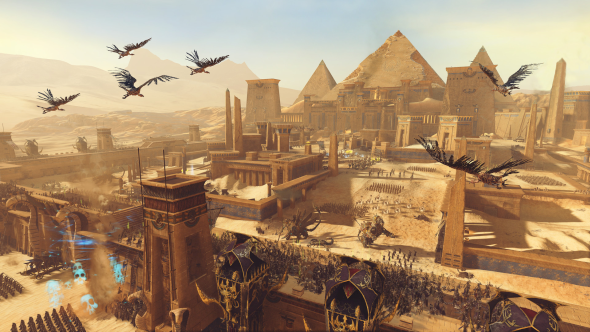
PCGN: Those elite units are interesting in that you need more recruitment buildings to unlock further copies of them. I imagine that puts a lot of pressure on your town configurations in the late-game that other races don’t have.
Aldridge: Yeah, correct, it’s very different in that regard. I would say, think of these guys as playing deep – you take your home settlement and you deeply build within that, rather than branching out to lots of different places. That way you can develop your race to its full potential – you can get to these illustrious tier-five units. Obviously, if you want to branch out, you are more than welcome to do that, but you might find that some things are harder to come by. The Tomb King economy is very small, compared to some of the other factions.
PCGN: Yeah, gold income is not generous.
Aldridge:That’s a kind of counter to the fact that you can amass these great armies. And you’ve got the dynasties, the great Pharaohs of old, and can look into what they did and you can bring some of those into the battlefield as well. So you can use your [Canopic] Jars to bring back these great warriors, and they’ve all got their own unique and intrinsic skills, and they all tie in to what that dynasty was famous for in the lore.
PCGN: The Tomb Kings are one of only two tabletop races with a neutral moral alignment. How does that affect their campaign? They don’t care about the Vortex at all, I notice.
Aldridge: Yeah, they don’t.
Deans: We wanted to tell their story – it felt like inserting them into the Vortex campaign was unnatural. We felt like the Tomb Kings didn’t really make sense without the overarching threat of Nagash and the Black Pyramid, so that’s where we centred the threat: the Black Pyramid, this superweapon that was developed way back, is stirring. It has got all the Tomb Kings worried, except Arkhan, who is trying to exploit the situation.
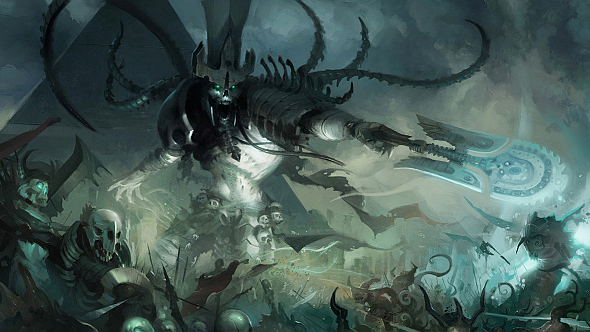
PCGN: You mentioned a name there. Obviously he’s a shadow that hangs over the Tomb Kings in the lore, massively. I know what the chance of getting an answer now is going to be, but will we get to see Nagash in the game at any stage?
Aldridge: Well, the Tomb Kings have got their own, very climactic, finale. But as we’ve said in previous interviews, and as we like to tell our fans, we’re evolving, we’re organic, we’re growing – more stuff’s going to come to the party as time will tell. We’ve got four brilliantly different Legendary Lords here, each with a different starting position.
We’ve got Arkhan and Settra starting in Nehekhara, or on the coast nearby. You’ve got Khalida down in Lustria – she’s hellbent on destroying the vampires there. And you’ve got Khatep, the poor old Grand Hierophant, who’s been exiled right out into Naggaroth. His campaign is about trying to get back into the good graces of his king [Settra].
Deans: It’s a redemption story.
Aldridge: It is. And then, for Mortal Empires, it’s the same again but different. We’ve got Khalida starting in Lybaras, her home city. Lore-hardened fans will be pleased to see she’s there, because that city doesn’t exist in the Vortex campaign. And we’ve got the other guys in their appropriate positions – Khatep is still in Naggaroth, trying to make his way home, and Arkhan is still trying to mix things up and cause trouble for everybody.
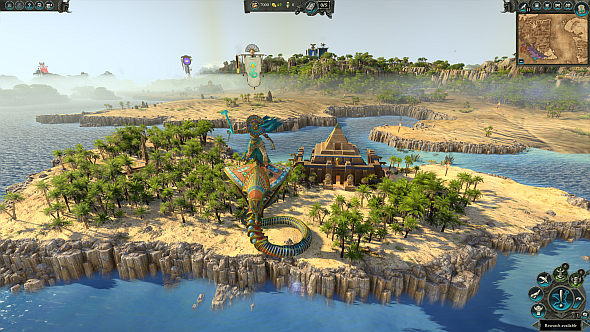
PCGN: Four Legendary Lords is more generous than we’ve seen in previous campaign packs, and we’ve got a very full roster as well, this time around. I believe it is only Bone Giants, or Necrolith Colossi, that are missing?
Aldridge: Yeah, whichever edition of the book that you’re more familiar with.
PCGN: And, in exchange, there’s no mini campaign. Why the change?
Aldridge: We heard what the fans were asking for, which was bigger army rosters, and more of the Legendary Lords, the big name characters. So we wanted to embrace that.
[To Deans] You are the unit master, so it’s great fun for you.
Deans: Absolutely. We work quite closely with Games Workshop, and they’re quite generous with allowing us to create our own units, with their blessing, to make the roster more complete. One problem we did have in the initial stages is that we had Skeleton Warriors and then Tomb Guard, which is a huge gap. So we added a unit called Nehekhara Warriors, which are more heavily armoured and dual-wielding. They serve as a stepping stone to the Tomb Guard.
There are also the Nehekhara Horsemen, who are your more heavily armoured melee cav – we’ve got them as well because we felt the Tomb Kings were lacking that versatility. I think the cherry on the cake, though, is the Hierotitan – he never had a model in the tabletop game.
PCGN: That’s true, I never really knew how it should look.
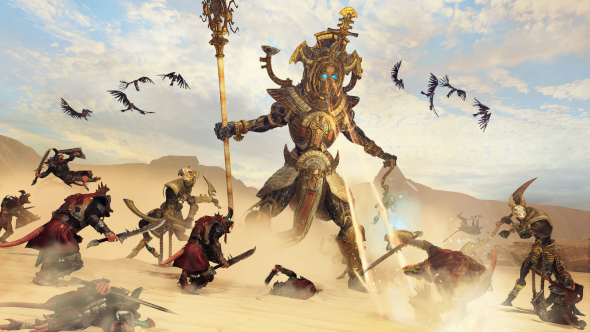
Deans: Yeah, so our artists and animators worked quite closely with Games Workshop to bring this guy to life.
PCGN: And it looks terrific, in the trailer.
Deans: It’s my favourite unit.
Aldridge: Yeah, we were reading all of the snippets and being like ‘what would this guy be?’. I remember sitting there one day and we read the thing about how he harnesses the power of the Sun God, Ptra, and somehow brings that to destroy those who oppose him. How would he do that? How about laser beams from his eyes? And no-one believed us to start off with. But here we have it – it’s wonderful.
Deans: For a bit of background on this unit, it is essentially a Liche Priest – one of the casters for the Tomb Kings – in a sarcophagus, which is embedded in the centre of what is essentially a giant mech. I just think the idea of this unit is absolutely amazing. I love it to bits.
Aldridge: I’d also like to mention the Tomb Swarm. I imagine many people would not expect we would even dare touch them, but we did, and we did it in a way that means you get to keep your full 20-stack of beautiful Nehkeharan constructs and warriors and all the rest. It is an army ability, so you get that tar pit experience from the tabletop, but not at the cost of using one of your slots. So you’ll get to see those nasty little scarabs doing their work.
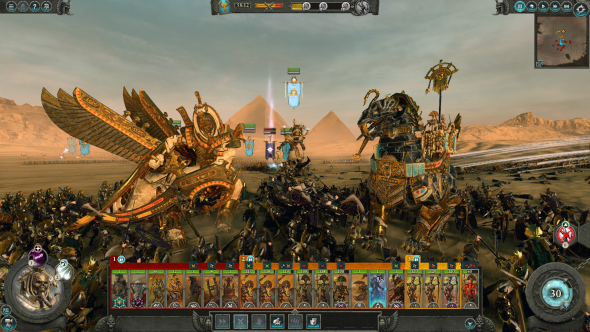
PCGN: Awesome. I want to cover a few more systems about the army – tell us a little about Tomb King magic. They get a new lore, correct?
Deans: It’s another lore of magic, absolutely, but it does tie into how the Tomb Kings heal their units. They’ve got quite a few cheap spells in terms of mana cost, so you can cast them quite frequently throughout the battle. Each time you do, they will heal and resurrect units across the entire army.
That’s important because the Tomb Kings don’t have an Invocation of Nehek, which heals Vampire units. That’s what we wanted to do from day one – we asked ‘how do we make Vampire Counts different from Tomb Kings?’, and the answer was to change how they summon, change how they heal, and give them ranged units. So the Tomb Kings have got catapults, archers, and Ushabti with greatbows, which are essentially mobile ballistas.
There are a bunch of spells which supplement all that. There’s Usirian’s Incantation, which is a ranged buff that raises armour piercing and normal ranged damage. Combine that with a guy with a ballista-sized bow, and you’ve got an extremely strong sniper unit. There’s Skullstorm as well, which is your magical vortex. That can combine with Khatep’s sandstorm vortex, so he can have two vortices spinning around the battlefield at once.
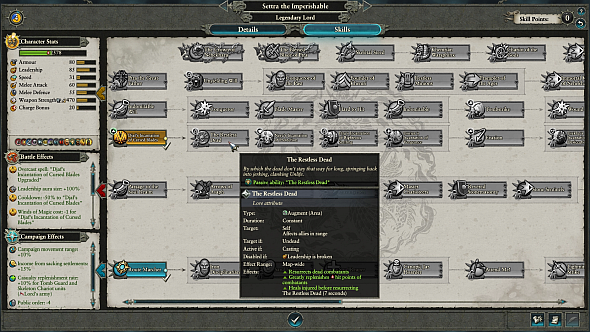
Aldridge: They’ve all got some nice starting abilities – as usual we don’t wanna leave anybody without a nice little surprise! So Khatep gets a sandstorm, and sandstorms are quite a big thing for us – we wanted to do more interesting things with the Rites system that came with Warhammer II, and we thought, ‘what’s more fitting for the Tomb Kings than to have their own sandstorm, that covers all their territories and protects them from invaders?’. So you’ll get that as a Rite, you’ll pop the button and the world will turn upside down.
PCGN: You see a graphical impact on the map?
Aldridge: You absolutely do.
PCGN: Very cool. I did actually notice a few new details on the campaign map that go beyond the new Tomb King cities.
Aldridge: We have gone back to that part of the world, and we’ve given it a nice lick of paint. There are new quest locations, which you’ll see, and without spoiling things there’s a great, epic finale for the campaign. There are also some very important quests for some of the characters to go on throughout the Vortex campaign, in particular. And we had to make Warhammer II the way it was, because the Tomb Kings were not there, so we wanted to put that right and include all the wonderful things that they bring to the Warhammer universe.
PCGN: And on that note, you’ve implemented the Tomb Kings’ Mortuary Cult – could you tell us a little about that?
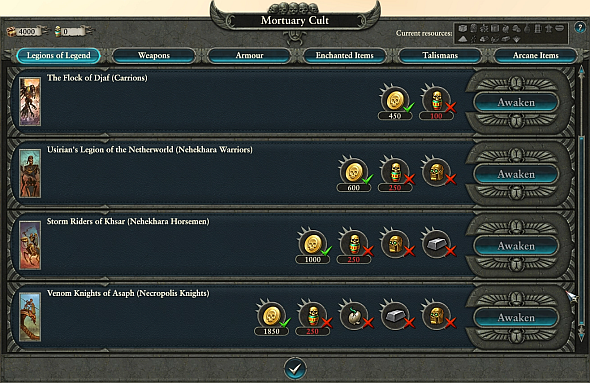
Aldridge: I guess it was one of those things that has always been on the back burner, which takes us more towards an RPG experience: how we’re expanding our characters, making them more unique, giving you lots of skills to dabble in. For me, the question was ‘how can we take that to another level?’ And reading about the Mortuary Cult, which is this secret crypt of the Liche Priests, and how they come about their incantations, it seemed like a very good fit; we can allow these guys to enhance the Tomb Kings’ characters.
We also wanted to incentivise the player to get out in that world, go and experience different places. As much as Nehkehara has a lot to offer, so does the rest of the world, especially in Mortal Empires. We wanted the different races to interact, to cross the seas. So with the Mortuary Cult, trade resources become a much more valuable commodity, and you’ll use them with Canopic Jars – which is the currency we’ve given the Tomb Kings – to craft these items. Some of them are quite basic, but they’ll get you rolling. Some are going to be legendary, and you’ll only be able to give one of them out to any of your Lords. And we absolutely want some kick-ass strong stuff in there to incentivise you to go after this.
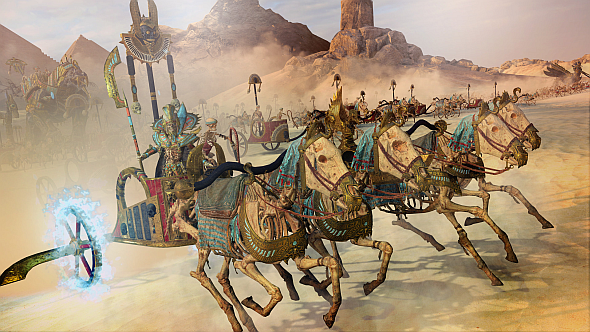
PCGN: It also makes items themselves more engaging because, right now, unless it’s a legendary, I feel almost as though they’re just notifications to dismiss after battle. I almost forget about them.
Deans: With Tomb Kings, though, we’ve lowered the drop rate for normal magic items. Normally other factions will get passive items through play, but with the Tomb Kings we want to incentivise players to pick different items and craft them for themselves.
Aldridge: So you can still get stuff, but hopefully you feel like ‘I really fancy that’, or ‘I’m going to deck out all my characters with this Speed Potion or Scorpion Armour’, or whatever it might be. It definitely allows you to roleplay.
Deans: You’ve got Legions of Legend as well, which is like a Regiments of Renown system – these are unique units, and you can only get one of each for the entire campaign. They require a huge investment, but they’re on another tier.
PCGN: So they’re even stronger than Regiments of Renown?
Deans: Yes, they’re even stronger than Regiments of Renown. And that’s why we’ve made them unique to the campaign, because we don’t want them running rampant in multiplayer. That allowed us the freedom to bump them up and make them that much better and that much more desirable, so the player will want to go and get, say, this Gem resource, or this Iron resource, in order to recruit them.
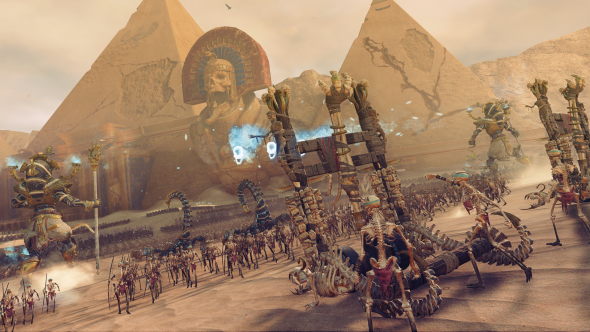
PCGN: Last couple of things, then. Can we expect smooth integration with the Mortal Empires DLC?
Aldridge: Yeah, it’s gonna be there from the get-go. So you’re gonna be able to play Vortex campaign or Mortal Empires with any of your preferred Lord choices.
PCGN: Terrific. And finally, this by my count makes 13 of the 15 eighth edition rulebook races in the game, and the last two are off the map, so presumably no more DLC until Warhammer III, right?
Aldridge: Haha! No, we’ll be working on some other bits and pieces. It’s very organic. We want to get all people’s favourite characters units, races, all of that, to come and join in. So we’ll be supplementing Warhammer II with more paid and free DLC content.
PCGN: Araby next?
Aldridge: Well, that would be an interesting one, wouldn’t it?
Deans: I don’t think I’ve heard of them before…
